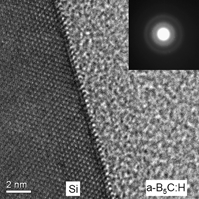Article contents
Kinetics of hydrogen in preparing amorphous B5C:H thin films
Published online by Cambridge University Press: 18 February 2011
Abstract

The kinetics of hydrogen in preparing amorphous boron carbide (a-B5C:H) thin films was studied. The hydrogen concentration of a-B5C:H thin films formed by plasma-enhanced chemical vapor deposition (PECVD) from a single-source precursor (o-B10C2H12) is ∼35–50 at.% as determined by nuclear reaction analysis. The hydrogen concentration of the a-B5C:H thin films is an exponential function of the precursor flux during the deposition. After annealing, the hydrogen concentration in the a-B5C:H thin films decreases with the increasing annealing temperature. The kinetics of hydrogen removal during annealing is controlled predominantly by its dissociation from PECVD radicals in the a-B5C:H thin films. The activation energy of about 0.14 eV is related to hydrogen dissociation from B–H bonds, but higher activation energy (∼0.44 eV) is required to strip the hydrogen atoms from C–H bonds in the thin films.
- Type
- Articles
- Information
- Copyright
- Copyright © Materials Research Society 2011
References
REFERENCES
- 8
- Cited by




